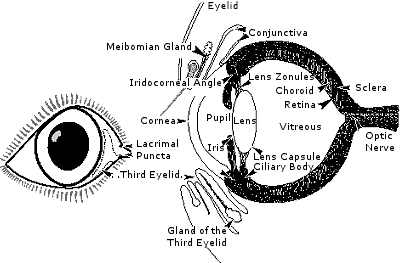PRA (progressive retinal atrophy)
All original NyaStar Irish Red and White Setters are DNA Tested CLEAR for PRA.
UPATE 2011: Late onset PRA has been found in IRWS, it is uncertain at this time if this genetic test is accurate or not. Please stay tuned for details
Progressive retinal atrophy (PRA) is an inherited disease which causes degeneration of the retina with irreversible blindness. In all breeds in which the type of inheritance has been identified, it is autosomal recessive. This means that each parent must carry an abnormal gene and that two parents who are not affected themselves may produce affected puppies.

The age of onset and rate of progression varies from breed to breed. Usually, the vision becomes affected when the dog is 6-8 years of age. The first sign observed is usually a loss of night vision, which progresses, usually within a few months, to a loss of daylight vision as well.
Although most cases of retinal degeneration are inherited, there is a spontaneous (non-inherited) form of this condition called Sudden Acquired Retinal Degeneration (SARD). Affected animals present develop sudden blindness; there is usually no history of exposure to poisons or signs of other diseases. Routine eye examination reveals no abnormalities (other than dilated pupils) in the early stages of the disease.
Diagnosis of inherited retinal degeneration (PRA) can usually be made by a veterinary ophthalmologist using an ophthalmoscope to examine the retina. Thinning of the retina and reduced size of the retinal vessels are observed. Occasionally, cataracts may occur secondary to retinal degeneration. In such cases, cataract surgery is obviously of no benefit. However, often a dog may not present for ophthalmic examination until the cataracts have progressed so that detailed examination of the retina is prevented by the cloudy lens. In such cases, electroretinography is essential to make this diagnosis and prevent an unnecessary surgery. Electroretinography is the electrical response recorded when the eye is stimulated by light. Even in the presence of a corneal opacity or cataract, sufficient light reaches the retina to cause a response provided that the retina is functional.
There is no treatment for any form of retinal degeneration. These conditions are painless and, in most cases, loss of vision progresses slowly and pets adjust to this handicap remarkably well. Animals which are irreversibly blind can live a normal lifespan and have an excellent quality of life. It is important to recognize that loss of vision does not represent the same handicap for our pets as it would for us. For us, blindness would mean an inability to read or drive a car and a loss of independence. Our pets are already (happily) dependent on us. It is important to keep their environment as safe as possible. A harness may work better than a collar for guiding your pet on walks outdoors -- a blind pet should never be allowed to run free. Try not to rearrange the furniture and you will be amazed at how well your pet will remember the floor plan -- even going up and down stairs. Swimming pools and balconies present particular hazards and some sort of barrier may be necessary in these situations. A blind pet can continue in every way in their primary role as a loving companion. Learn more about helping a blind pet adjust.
